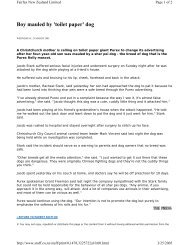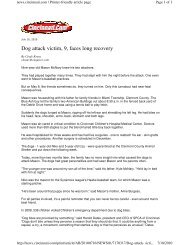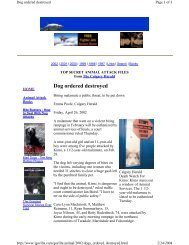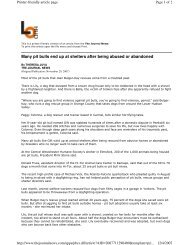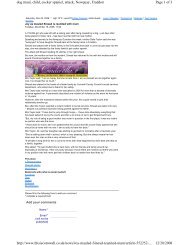A community approach to dog bite prevention - American Veterinary ...
A community approach to dog bite prevention - American Veterinary ...
A community approach to dog bite prevention - American Veterinary ...
You also want an ePaper? Increase the reach of your titles
YUMPU automatically turns print PDFs into web optimized ePapers that Google loves.
ehaviour problems of the <strong>dog</strong> and cat. Bos<strong>to</strong>n: Butterworth-<br />
Heinemann, 1997;129–150.<br />
59. Lund JD, Vestergaard KS. Development of social behaviour in<br />
four litters of <strong>dog</strong>s (Canis familiaris). Acta Vet Scand 1998;39:183–193.<br />
60. Mathews JR, Lattal KA. A behavioral analysis of <strong>dog</strong> <strong>bite</strong>s <strong>to</strong><br />
children. Dev Behav Ped 1994;15:44–52.<br />
61. Neilson JC, Eckstein RA, Hart BL. Effects of castration on<br />
problem behaviors in male <strong>dog</strong>s with reference <strong>to</strong> age and duration<br />
of behavior. J Am Vet Med Assoc 1997;211:180–182.<br />
62. Net<strong>to</strong> WJ, Planta DJU. Behavioural testing for aggression in<br />
the domestic <strong>dog</strong>. Appl Anim Behav Sci 1997;52:243–263.<br />
63. O’Farrell V, Peachey E. Behavioural effects of ovariohysterec<strong>to</strong>my<br />
on bitches. J Small Anim Pract 1990;31:595–598.<br />
64. Overall K. When <strong>dog</strong>s <strong>bite</strong>: what you don’t know can kill<br />
<strong>dog</strong>s. DVM Newsmagazine 1998;Apr:13S–20S.<br />
65. Overall K. Clinical behavioral medicine for small animals. St<br />
Louis: Mosby, 1997;88–137.<br />
66. Overall KA. Sex and aggression. Canine Pract 1996;20:16–18.<br />
67. Overall K. Fearful aggression, anxiety case leads <strong>to</strong> intensive<br />
behavior modification pro<strong>to</strong>col. DVM Newsmagazine 1995;May:<br />
6S–10S.<br />
68. Overall KL. Early intervention by owner can help prevent<br />
inappropriate play aggression. DVM Newsmagazine 1993;26(9):43.<br />
69. Reisner IR, Erb HN, Houpt KA. Risk fac<strong>to</strong>rs for behaviorrelated<br />
euthanasia among dominant-aggressive <strong>dog</strong>s: 110 cases<br />
(1989–1992) J Am Vet Med Assoc 1994;205:855–863.<br />
70. Tan JS. Human zoonotic infections transmitted by <strong>dog</strong>s and<br />
cats. Arch Intern Med 1997;157:1933–1943.<br />
71. Underman AE. Bite wounds inflicted by <strong>dog</strong>s and cats. Vet<br />
Clin North Am Small Anim Pract 1987;17:195–207.<br />
72. Wright JC. Canine aggression: <strong>dog</strong> <strong>bite</strong>s <strong>to</strong> people. In: Voith<br />
VL, Borchelt PL, eds. Readings in companion animal behavior. Tren<strong>to</strong>n,<br />
NJ: <strong>Veterinary</strong> Learning Systems, 1996:240–246.<br />
73. Zoonotic diseases in the immunocompromised: roles of<br />
physicians and veterinarians. Am Assoc Food Hyg Veterinarians News-<br />
O-Gram 1998;Nov/Dec:14–15.<br />
74. <strong>American</strong> <strong>Veterinary</strong> Medical Association. People and animals<br />
sharing the world. Schaumburg, Ill: <strong>American</strong> <strong>Veterinary</strong><br />
Medical Association, 1993.<br />
75. Fleisher GR. The management of <strong>bite</strong> wounds. N Engl J Med<br />
1999;340:138–140.<br />
76. Talan DA, Citron DM, Abrahamian FM, et al.<br />
Bacteriologic analysis of infected <strong>dog</strong> and cat <strong>bite</strong>s. N Engl J Med<br />
1999;340:85-92.<br />
Appendix 1<br />
Groups potentially involved in <strong>dog</strong> <strong>bite</strong> <strong>prevention</strong><br />
A model program for preventing <strong>dog</strong> <strong>bite</strong>s begins with assembling a local<br />
coalition. Wide representation of <strong>community</strong> views on the coalition helps<br />
ensure sufficient input and <strong>community</strong> acceptance of the program. Key players<br />
include:<br />
? animal control officials<br />
? at<strong>to</strong>rneys, judges<br />
? business sec<strong>to</strong>r (eg, local business leaders, insurance companies, pet<br />
s<strong>to</strong>res)<br />
? <strong>dog</strong> breeders and trainers<br />
? educational system (eg, schools, parent-teacher organizations)<br />
? health departments and public health associations<br />
? humane societies<br />
? human healthcare providers and associations (eg, nurses, pediatricians,<br />
<strong>community</strong> health centers, emergency medical service and ambulance<br />
companies, health maintenance organizations, hospitals, managed care<br />
organizations, medical associations, medical examiners’ and coroners’<br />
offices, schools of medicine and public health, trauma centers)<br />
? kennel clubs, <strong>dog</strong> clubs, assistance <strong>dog</strong> organizations<br />
? law enforcement agencies<br />
? local government officials<br />
? media<br />
? occupational safety organizations, agencies, and groups (eg, firefighters,<br />
meter readers)<br />
? veterinary care providers and associations, allied staff, clinics, schools<br />
of veterinary medicine and veterinary technology<br />
? volunteer nonprofit organizations (eg, boy/girl scouts; various “Y”s; 4-H<br />
clubs; chapters of the <strong>American</strong> Red Cross, Safe Kids, National Safety<br />
Council, and National Fire Protection Association; foundations; United<br />
Way; and civic groups [Kiwanis, Rotary])<br />
? other groups (eg, sports recreation clubs [joggers, bicyclists], au<strong>to</strong>mobile<br />
clubs, extension offices)<br />
Continued on next page.<br />
1746 Vet Med Today: Canine Aggression Task Force JAVMA, Vol 218, No. 11, June 1, 2001



